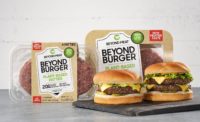Beyond the Veggie Burger
By Lynn Petrak, Special Projects Editor
Like their animal protein counterparts, meat analog manufacturers seek to boost their category through diversification and process improvements.
Not too long ago, there was a time when meat analogs were construed by many as bland-tasting niche products bought by those who favored bean sprouts, animal rights, cheaper protein sources. or a combination thereof. These days, however, meat substitutes have graduated to a higher level of product development and marketing, with broader product lines, savvier promotional support, and non-traditional packaging.
Plain and simple, non-meat protein — by way of tofu pieces and veggie patties — has given way to more sophisticated meat-analog products found in the supermarket freezer and refrigerated meat case, as well as on the menu at restaurants and institutions ranging from upscale establishments to dormitory cafeterias to military bases.
What’s more, meat analogs aren’t produced by vegetarian-only companies these days.
Although many that formulate analogs still specialize in meatless food products, several analog manufacturers have been brought into the fold of major food conglomerates, including those that process both “real” and faux meat products through different divisions.
Sonja Tuitele, director of corporate communications for Boulder, CO-based Wild Oats Markets Inc., supports the notion that, at least on the retail level, there has been a real trend of diversification and a move to more mass-market production of analogs. “We have increased the variety of offerings to include complete vegetarian meals as well as chicken substitutes. Customers can now even get a complete vegetarian Thanksgiving dinner made with meat substitutes,” she reports. “The quality has also increased, as more and more products become readily available.”
Recent market research data underscores that this remains an intriguing category to watch. According to figures from Chicago-based Information Resources Inc. (IRI), branded meat substitutes in total racked up more than $5.4 billion in sales over the last 12 months, with a few vendors experiencing increased sales.
At the same time, however, meat and poultry processors with a competitive streak might be heartened to learn that overall category sales were down 7.5 percent from last year. In addition, many meat substitutes suffered losses — nine of the 10 top-branded meat substitutes were in the negative territory last year. One product’s sales plummeted by nearly 50 percent.
History lessons
Despite the recent losses, this category is one to monitor, if only because it has shown staying power through decades of ebbs and flows in sales. The analog market had its commercial beginnings in the 1920s and ‘30s, when interest in vegetable-based diets and healing practices at the time led to the development of substitutes, including a line of meatless meats produced by J.H. Kellogg’s Battle Creek Food Co. Other meat-free products followed, including items like meatloaf made with wheat gluten, peanuts, and defatted soy grits and “choplets” formulated from wheat gluten and a broth of yeast extract and mushrooms.
In the 1940s, rations of animal meats led to other types of analogs, including the first broad use of soy as an ingredient. The late 1950s and ‘60s brought renewed interest to such products, thanks to the changes in food manufacturing and interest in “space age” foods. “In the ‘60s, there was a big push for meat analogs,” notes Robert Rust, Ph.D., an emeritus professor of animal science at Iowa State University who has worked on soybean-related projects. “But I think the market was overestimated, and as a result it turned into a financial disaster.”
Later, the health focus of the 1970s and 1980s brought a focus back to meat substitutes, but in a narrower and more defined way, with the emergence of the strict vegetarian niche. In the 1990s, the veggie burger began to gain traction among a growing group of consumers and was mass marketed by brands such as Boca® and Gardenburger®, among others.
Jim Anderson, technical manager for ingredient supplier BK Guilini Corp, Simi Valley, CA, which supplies phosphates mainly for meats but with some applications in meatless product emulsions, echoes the fact that this is a category with peaks and valleys. “It goes in spurts. I think since the early ‘90s, I’ve seen interest come in waves three or four times,” he says.
Even with the converging trends of product-line diversification and SKU sales declines, this appears to be another period in time in which the market for meat analogs is changing. Henk W. Hoogenkamp, an expert based in the Netherlands who has written several books on the topic of meat analogs, says that there has been a notable shift in the profile of those who are purchasing meat substitutes, including those in the United States.
“Way back in the ’60s, the market for meat analogs was mainly driven by pure vegetarians. Those ‘hard liners’ sacrificed taste and texture and ate the product no matter what,” he observes. “Over the years, the definition of vegetarianism has changed, I am not talking about the many sub-categories here, such as pesco, lacto, ovo, lacto-ovo vegetarians, but I am talking about an entire new category called the ‘lifestyle consumer’."
Hoogenkamp says that this latest type of buyer can be a harder one to pinpoint. “Lifestyle consumers are environmentally ‘engaged,’ want to feel good about themselves, and are prepared to make a statement. Lifestyle consumers do not always act logically and often base their decisions on the principle ‘perception is reality,'” he explains. “In their search to make a statement, they are prepared to limit the meat intake — not that they don’t like to eat meat, but for numerous reasons they believe that it is good to reduce or limit the intake.”
Such "pseudo vegetarians," as Hoogenkamp calls them, include mothers of young children and students who eat meatless meals once or twice a week. Still, as this group expands in numbers and food-dollar influence, the subcategory of core vegetarians remains somewhat small. “The pure vegetarian-driven consumer segment is not growing at all. This market segment represents only 0.7 percent of the population. The real future is lifestyle foods,” Hoogenkamp notes.
Other observers note a similar surge in lifestyle-driven consumers. “This category isn’t just supported by vegetarians. It is based on folks who have balanced lifestyles, making sure that overall they are living a healthier lifestyle. They eat meat on a certain day and eat meatless on other days,” says Tom Moe, brand manager for Madison, WI-based Boca Foods, part of food conglomerate Kraft Foods Inc.
Moe relays that health-conscious, lifestyle-driven buyers are not the same consumers who look for trendy foods like low-carb options. “Overall, these consumers are definitely very nutritionally savvy — they are not fad dieters,” he says.
Tuitele agrees that the audience for meatless products continues to widen. “Customers truly run the gamut here. While this was a vegetarian movement five to ten years ago, meat substitutes have really gone more mainstream,” she says, citing the continued emphasis on nutrition and health. “I think that customers are more aware of the need to incorporate lower fat and lower cholesterol protein items into their diet.”
More or (meat)less
To accommodate an evolving consumer base, manufacturers have been at work developing new meatless products, many of them value-added or presented in a meal solution format.
Boca is one example. After successfully launching a meatless pizza line in 2002, the company decided to pursue more entrée-style products.
“Those did very well in the marketplace, and with that we dovetailed into convenient meal solutions,” says Moe, adding that that a meatless lasagna made with ground Boca burgers was introduced nationally last year to a strong reception among retailers and consumers.
Most recently, Boca introduced a meatless chili. “Once again, we are leveraging the ground burger as an ingredient. The flavor is very bold, and if you look at the profile it is a nutritional poster child, with thirteen grams of fiber and one-hundred and fifty calories,” Moe says.
Other analog manufacturers have been working on meatless meal solutions as well. Battle Creek, MI-based Kellogg USA Inc., which started in the meat analog business decades ago, introduced Morningstar Farms Chili Pot Pie last fall, made of three-bean blends, pieces of veggie burger, tomatoes, and spices toped with pieces of cornbread. Even a veggie burger isn’t just a veggie burger anymore with Morningstar®, which offers varieties like Spicy Black Bean Veggie Burgers, Portabella Mushroom and Oven Roasted Vegetable Veggie Burgers, and Philly Cheese Steak Veggie Burgers, in addition to veggie burger-style and sausage-style crumbles for use in recipes.
Another leading meat substitute vendor, Gardenburger Authentic Foods Co., Irvine, CA, has delved into the heat-and-serve arena with an assortment of Gardenburger® Meals, including Meatless Herb Grilled Chicken with Vegetables, Meatless Meatballs with Penne Marinara, Meatless Citrus Glazed Chicken with Green Beans and Rice, and Meatless Meatloaf with Broccoli and Red Peppers.
In addition to veggie burgers used in different applications like lasagna, meatballs, and chili, tofu is being developed in innovative ways for meat substitute products. One example is a line of TofuTown Grilled Tofu Tenders from White Wave, a business of Dallas-based Dean Foods/Morningstar Foods. The pre-marinated tofu-based meal solutions are available in varieties such as Havana Black Bean, Mediterranean Tahini, Sesame Ginger Teriyaki, and Tamari, and the company recently led a major couponing and sampling effort to promote them.
Meanwhile, just as veggie burgers were created to give beef and other ground-meat burgers a run for consumers’ money, some analog processors are trying to do the same with other traditional meat products. Morningstar Farms, for example, offers Veggie Dogs, including veggie corn dogs and mini corn dogs, while a company called Mon Cuisine Natural Products in Maspeth, NY has introduced a party favorite box with vegan cocktail franks. On the lunchmeat side, Ian’s Natural Foods, Revere, MA, recently introduced a line called Ian’s Today’s Deli Meatless Deli Meat, which includes meatless New York-style pastrami. And the Lightlife brand, owned by Omaha, NE-based ConAgra Foods, includes Smart Deli® Slices and Smart Dogs® fashioned from soy protein.
Although a lot of the recent R&D focus in this industry has been on new applications for soy protein and vegetable protein, there has been a move afoot to improve the appetite-appeal of the products, which have earned a hard rap of sorts over the years. Boca, for example, recently developed new-and-improved chicken patties and nuggets, and it reformulated its line of meatless breakfast links and patties.
“It all comes down to taste in this category,” acknowledges Moe. “In terms of overall advancements in the meatless arena, the two main ones have been centered around removing bean-y flavors and improving texture. Mouthfeel is extremely important to our customers.”
Moe relays that the company tries to provide what consumers ultimately want from their meat-free products. “We’ve been trying to stay true to the positive nutritional profile — you don’t want to walk away from what makes this product special,” he remarks. “And while some want it to taste much like meat, there are others who are not as much into the meat taste as the high flavor profile.”
Hoogenkamp believes that there is potential for even better formulations. “Technology capabilities of both semi-moist extruded meat analogs and integrated textured particles have greatly improved over the last few years,” he relays, noting that most of that technology has been driven by entrepreneurial companies.
On the other hand, Hookegnamp says many major manufacturers haven’t effectively positioned their range of textured-soy proteins for the meat-analog segment. “In the past, meat-free products such as burgers and patties were mainly based on textured soy protein combinations embedded in a finely-comminuted emulsion. It is clear that modern consumers have moved forward and are demanding products of better quality such as texture, bite, and flavor,” he points out. “Products that are based on soy protein only cannot deliver these properties.” As a result, Hoogenkamp reports that some technologies are now focused on using integrated textured particles made from combinations like wheat gluten, pea protein, soy protein, lupein protein, egg albumen, and modified food starch.
In addition to advancements in soy protein and vegetable protein, there have been improvements in the equipment used to produce analogs. Clextral Inc., Tampa, FL, which offers systems for both vegetable and meat-based products, recently announced a new process to create fiberized protein products with realistic meat texture, taste, and mouthfeel made from raw vegetable protein sources. The technology is based on a new twin-screw extrusion method, and the resulting products can be used by manufacturers in ready-to-eat entrées, as sandwich fillings or for pizza and sandwich toppings.
The meat of the manufacturing matter
To some degree, capabilities for high-tech equipment and new product development in this category are improving because many once-small vegetarian manufacturers are now part of larger food companies with more resources. To name just a few, the Lightlife brand was bought by ConAgra, the Boca brand was acquired by Oscar Mayer, and the White Wave brand is now under the Dean Foods umbrella.
Sarah Delea, spokeswoman for Boca (and also for the Oscar Mayer family of products), says the arrangement among various Kraft divisions has proven beneficial in a variety of ways. “We always bring in our suppliers when we talk about products from beginning to end. With the Boca pizza, for example, when we were looking at the development of meatless pepperoni, we asked what type of equipment was needed. And with experience on the meat side, we have learnings from that,” she says.
Some experts add that meat-processing companies would be well served to keep an eye on, and maybe a hand in, the analog market. “Of course there is a future for traditional meat companies who want to enter the lifestyle segment. I am not talking about old-style meat products such as pastrami or corned beef. But every meat product of which the perception can be changed basically classifies,” says Hoogenkamp.
Rust, who has researched the use of soybeans in hog feed and understands both the soy market and the animal-protein industry, concurs. “Someone will buy a vegetarian hot dog, so who is best equipped to do it?” he asks. “My advice to meat companies is to get out and do it before someone else does.” NP



Report Abusive Comment